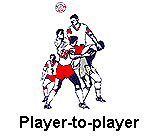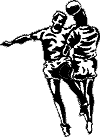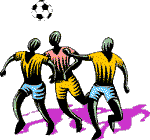 | Soccer and the Brain (Heading for Trouble?) |  |
 | Soccer and the Brain (Heading for Trouble?) |  |
| Soccer: the most popular team sport in the world. Millions of people play the game and over a billion people watch the World Cup soccer championship. | ||
|
What a game! Where else do people use their heads to bounce balls going 100 kilometers/hour? |
Although soccer is a relatively safe sport, the game does involve contact.
This contact can be:
|

|
|
As you might expect, most (50-80%) soccer injuries affect the feet and
legs. However, the American Academy of Pediatrics concluded that the
contact that occurs
while playing soccer is at the same level as during
boxing, football, ice hockey, lacrosse, rodeo and wrestling and field
hockey. Head injuries account for between 4% and 22% of all soccer injuries. Can this contact cause brain damage? Let's look at the data.
| ||
The DamageConcussions A concussion may
occur when someone's head strikes an object. A person with a concussion
may lose consciousness or suffer memory loss and appear confused. In
soccer, concussions make up 2-3% of all injuries. This is the same
rate as for American football! A concussion may
occur when someone's head strikes an object. A person with a concussion
may lose consciousness or suffer memory loss and appear confused. In
soccer, concussions make up 2-3% of all injuries. This is the same
rate as for American football!
|
Brain DamageA Norwegian study found that 35% of 69 Division I soccer players had abnormal electroencephalogram (EEG) patterns. This is more than twice the rate of abnormal EEG patterns in control subjects. Retired soccer players had several brain abnormalities including reduced cortical tissue and increased lateral ventricle size. |
Neuropsychological EffectsSoccer players also seem to perform more poorly than control subjects on some types of IQ tests and many former players (81%) suffer from problems with attention, concentration, and memory. Players who typically head the ball have also been found to have more neurological problems than non-headers. Compared to goalies and midfielders ("non-headers"), forwards and defenders ("headers") performed more poorly on some memory, visual perception and planning tests. |
The Controversy: Does Heading the Ball Cause Damage? | ||
 |
Soccer balls kicked by highly skilled players can travel over 100
km/hour.
Although these ball speeds are not reached during most recreational games,
some people believe that young players should wear protective helmets. Heading of the ball may have caused the neurological problems reported in soccer players. However, it is possible that other types of head injury were responsible for these injuries. For example, many professional soccer players suffer head injuries when they collide with other players or hit the ground. Therefore, soccer-related brain injury may not necessarily be due to heading the ball. On the other hand, it is unknown if repeated low intensity impacts, like those that occur when the ball is headed, make players more susceptible to later impacts. Most of the data come from players at the elite level who have played soccer for many years. Professional soccer players head the ball thousands of times during their careers. There has not been much research on the effects of heading the soccer ball on children or recreational players. Although helmets may protect players from concussions, their usefulness has not been tested. At least one company is selling helmets to be used by children while playing soccer. |  |
Possible Protections So, how can head injuries be
reduced and minimized? Here are some
recommendations: So, how can head injuries be
reduced and minimized? Here are some
recommendations:
|
| Did you know? |
There are very few soccer-related deaths. However, the US Center for Disease Control reported that 18 people between 1979 and 1993 had been killed by falling goalposts. Of these 18 people, 14 had head injuries and most were children who were climbing on unstable goalposts, not playing soccer. |
|
For more information on soccer and the brain, see:
|
| BACK TO: | Neurological and Mental Disorders | Exploring the Nervous System | Table of Contents |
![[email]](./gif/menue.gif) Send E-mail |
 Get Newsletter |
 Search Pages |
 Donate to Neuroscience for Kids |